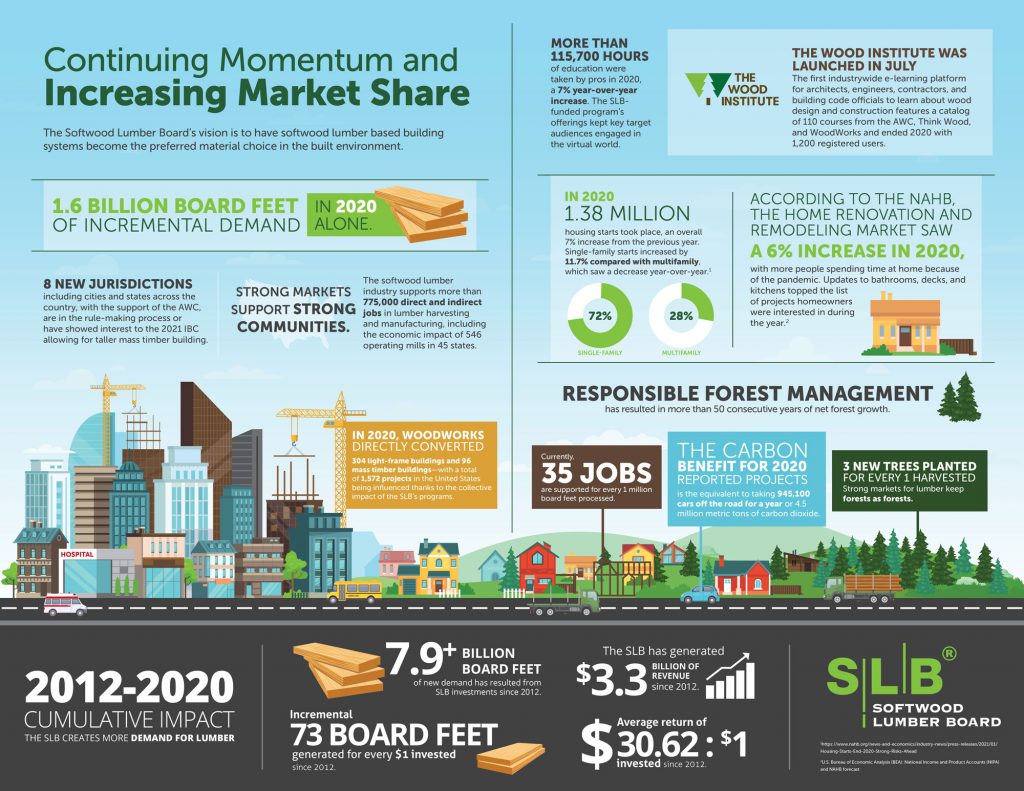HIGHLIGHTS
PROGRAM UPDATES
WoodWorks to Launch Effort to Expand Wood in Government Projects New AWC Resource Pinpoints Accurate Design Values of Multispecies Grade Marks The AWC to Participate in New ICC Wildfire Hazard Code Development Think Wood Launches Content to Highlight Outdoor Living and Remodeling Trends Think Wood Media Sponsorship Touts Mass Timber Benefits to DevelopersINDUSTRY NEWS
The SLB, Funded Programs on List of Key Mass Timber Stakeholders Vancouver Takes on Embodied Carbon OSU’s Mass Timber Buildings Sequester 2,000+ Tons of Carbon British Columbia Prioritizes Mass Timber in Post-Covid Economic Recovery Michigan State U. Hopes to Spur Regional Adoption of Mass Timber WoodWorks Expertise on Display in Bisnow Piece on Embodied Carbon Holes and Wood Combine to Offer New Noise-Reduction Innovation FPInnovations Stresses Tall Wood Buildings as Key to Achieving Canadian Climate GoalsProgram Updates
WoodWorks to Launch Effort to Expand Wood in Government Projects
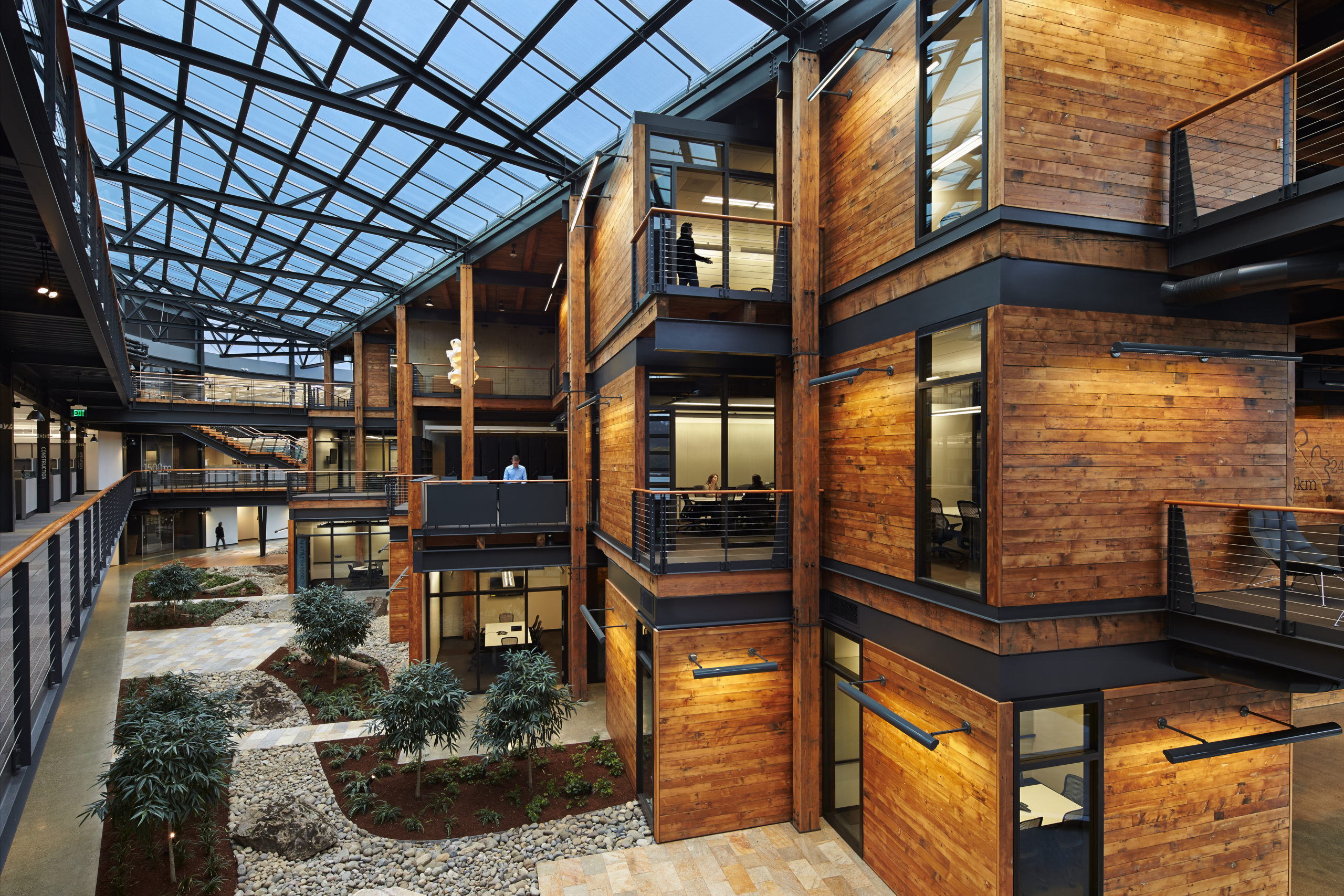
Federal Center South – Building 1201, Seattle, ZGF Architects, photo Benjamin Benschneider
In an effort to bolster wood use in U.S. government buildings, WoodWorks will soon reach out to scores of architecture, engineering, and construction firms that are preapproved to do business with the General Services Administration and other federal and state government agencies. As part of its outreach effort, WoodWorks is creating materials that overview wood options for government structures, provide examples of successful projects, and link users to relevant design and technical resources that illustrate how wood can provide solutions for a diverse array of public projects.
New AWC Resource Pinpoints Accurate Design Values of Multispecies Grade Marks
The AWC collaborated with several lumber grading agencies and the American Lumber Standards Committee (ALSC) to develop Table 4G, detailing current multispecies lumber grade marks, which has been included as an addendum to the AWC’s 2018 National Design Specification® (NDS®) Supplement. Table 4G provides a widely available, simplified resource to support designers and regulators in identifying and incorporating the correct design values when using lumber with multispecies grade marks.
View Table 4G here.
The AWC to Participate in New ICC Wildfire Hazard Code Development
By virtue of its seat on the International Code Council’s (ICC’s) Multi-Hazard Resiliency for Residential Construction (MHRRC) Committee, the AWC will play an active role in the development of a new Standard for Residential Construction in Regions with Wildfire Hazards/ICC 605, which will specify enhanced, prescriptive methodologies for wildfire-resistant design and construction details in such areas. The ICC expects that it will take the committee several years to develop the standard and that ultimately ICC-605 may replace the existing International Wildland Urban Interface Code.
The MHRRC Committee most recently updated the ICC Standard for Residential Construction in High-Wind Regions, ICC 600-2020, which references the AWC’s 2018 Wood-Frame Construction Manual for One- and Two-Family Dwellings standard for wood-frame construction requirements.
Think Wood Launches Content to Highlight Outdoor Living and Remodeling Trends
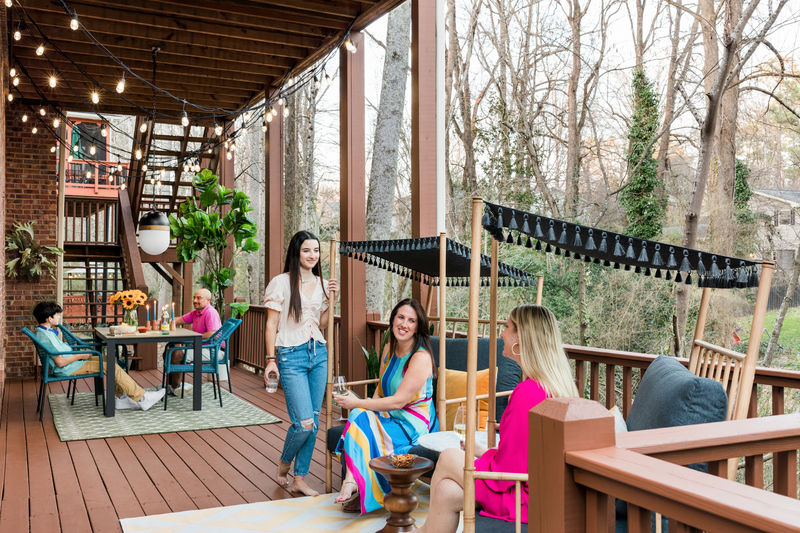
Think Wood partnered with Instagram influencer and Magnolia Network star Brian Patrick Flynn to produce inspiring new video and photographic content targeting homeowners and contractors and featuring softwood lumber interior and exterior applications. The content is designed to piggyback on the pandemic-era rise in home renovation and remodeling and is just in time for deck season. It promotes four popular trends: screened-in decking, pergolas, interior wood feature walls, and wood ceilings.
Think Wood will use both the videos and photographs to promote the outdoor living season and home renovation on its social channels, including Facebook, and via blog posts, such as this blog on top remodeling trends for 2021, which is being cross-promoted to Brian Patrick Flynn’s followers on Instagram.
Watch the video here.
Think Wood Media Sponsorship Touts Mass Timber Benefits to Developers
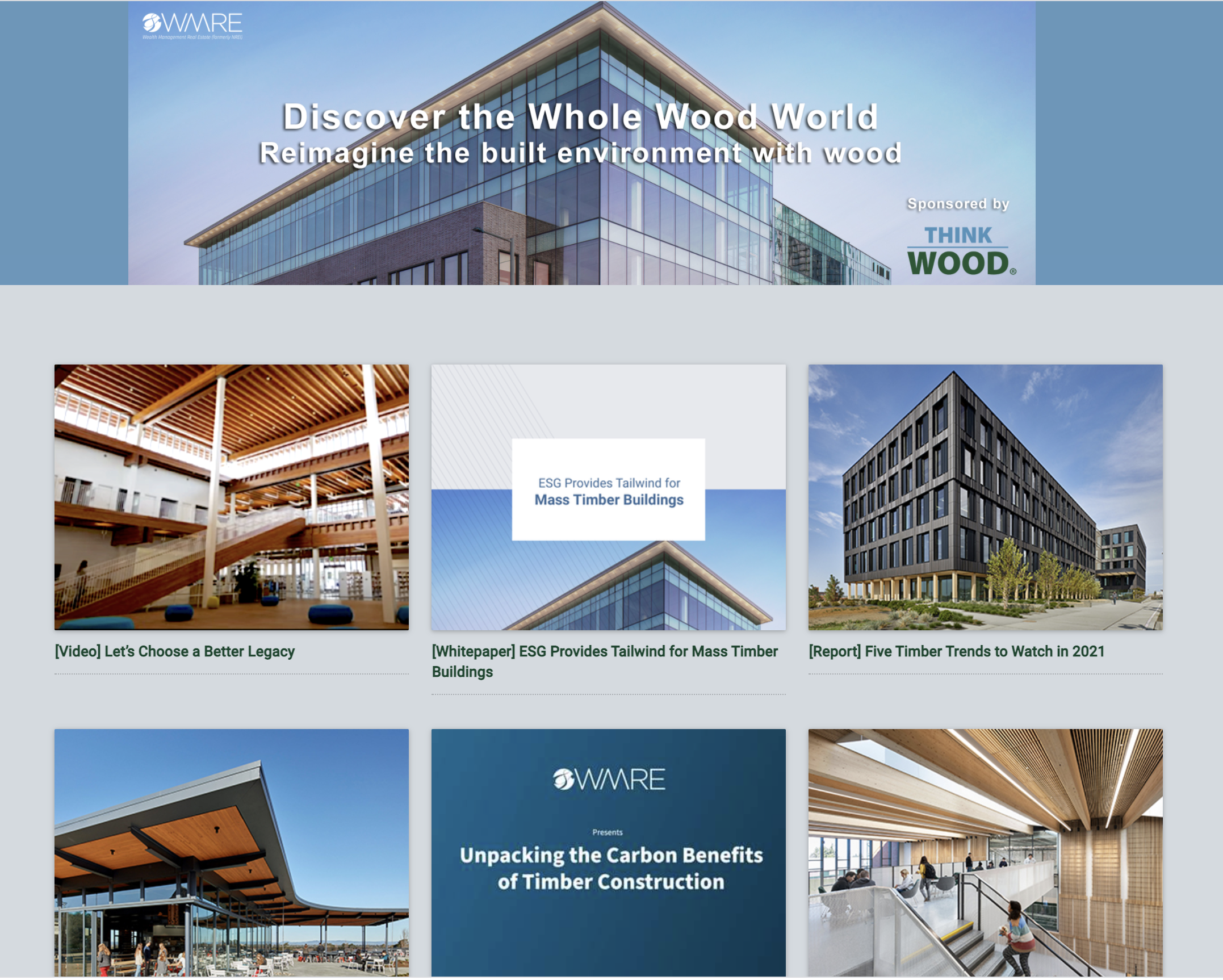
Think Wood contracted WealthManagement Real Estate (WMRE) in a strategic media partnership to promote Think Wood’s resources on WMRE’s Continuing Education Center (CEC) portal. The CEC provides on-demand content to developers, builders, property owners and managers, private real estate investors, and corporate real estate audiences.
Through the end of May, the CEC will feature new content created by WMRE and sponsored by Think Wood, including a new white paper, ESG Provides Tailwind for Mass Timber Buildings, and the FastChats video interview with Alan Organschi, as well as other Think Wood assets, including the Legacy video, Biophilic Design LookBook, and Timber Trends.
In the first month of the partnership, Think Wood resources generated 218 contacts and nearly 400 resource downloads and video views.
Industry News
The SLB, Funded Programs on List of Key Mass Timber Stakeholders
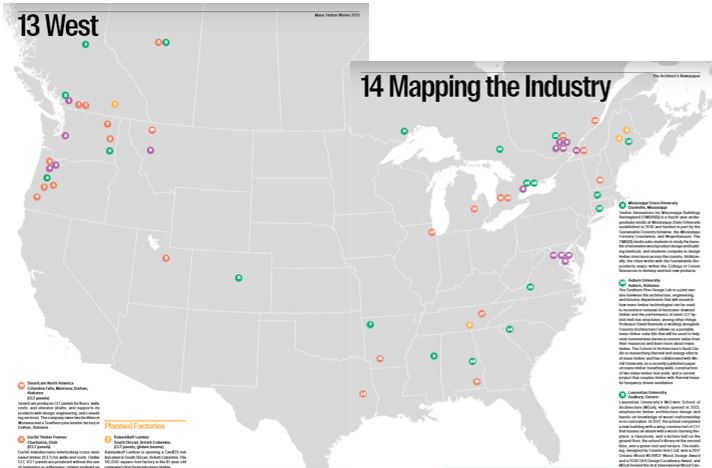
The Architect’s Newspaper has published an updated timber map, its annual listing of key regional and national universities, research and industry organizations, and manufacturers that are leading the way in mass timber research and development. The SLB, the AWC, Think Wood, and WoodWorks are among the U.S. and Canadian groups listed. The Architect’s Newspaper teamed with the Mass Timber Institute and the U.S. Forest Service’s Wood Innovations Program to validate the list.
Access the 2021 timber map here.
Vancouver Takes on Embodied Carbon

Vancouver is working to be on the leading edge of reducing emissions from the building sector through embodied carbon. Vancouver started requiring new construction projects to provide a whole-building life cycle assessment (LCA) in 2017, and its Climate Emergency Action Plan, adopted in 2020, requires all new buildings in the city to achieve a 40% reduction in embodied carbon from 2018 levels by 2030.
A report commissioned by the city using the LCAs submitted to date found that greater proportions of wood in a building led to greater declines in its embodied emissions, while greater proportions of concrete and steel led to greater increases. This data is supplemented by recent studies of Brock Commons, the mass timber tower completed on the University of British Columbia’s campus in 2017, which conclude that Brock Commons’ construction avoided 748 tons of greenhouse gas emissions (estimate by the Canadian Wood Council) and that its use of mass timber for structural elements resulted in a 36% reduction in global warming potential based on lower embodied carbon.
Read more about Vancouver’s efforts here.
OSU’s Mass Timber Buildings Sequester 2,000+ Tons of Carbon
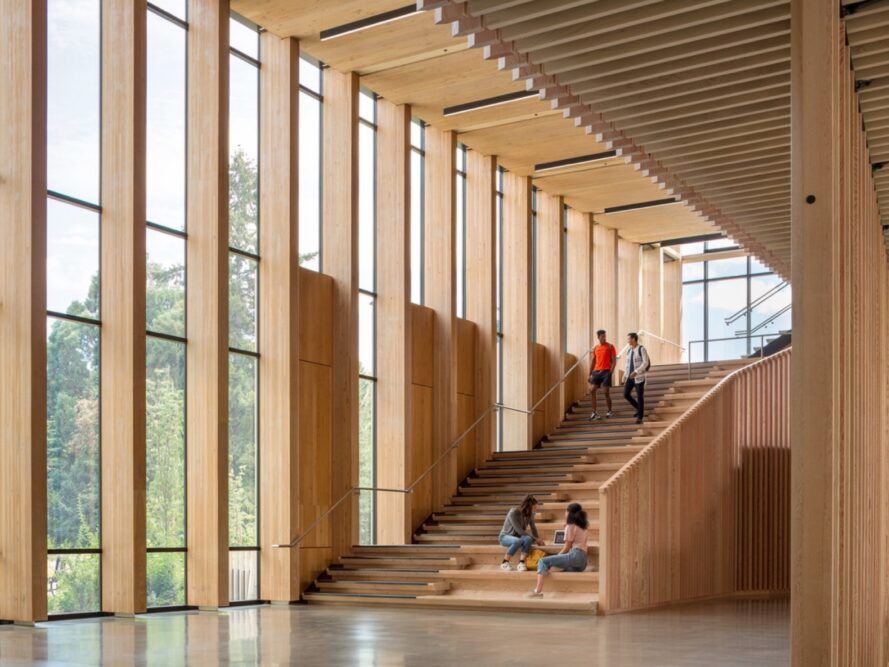
Inhabitat, an online green design and technology site, recently published a photographic tour of the College of Forestry at Oregon State University’s two mass timber buildings that opened last year—the 83,000-square-foot Peavy Hall and the 18,000-square-foot Advanced Wood Products Laboratory (AWP). Both buildings were designed by Canada-based Michael Green Architecture and together incorporate 2,130 cubic meters of wood that store 2,077 U.S. tons (1,884 metric tons) of carbon dioxide.
The buildings embody the mission of the college by combining material and performance innovations, reduced emissions through embodied carbon and optimized energy efficiency, and strong and direct linkages to Oregon’s forestry industry and economy.
Read more about the structures here.
British Columbia Prioritizes Mass Timber in Post-Covid Economic Recovery
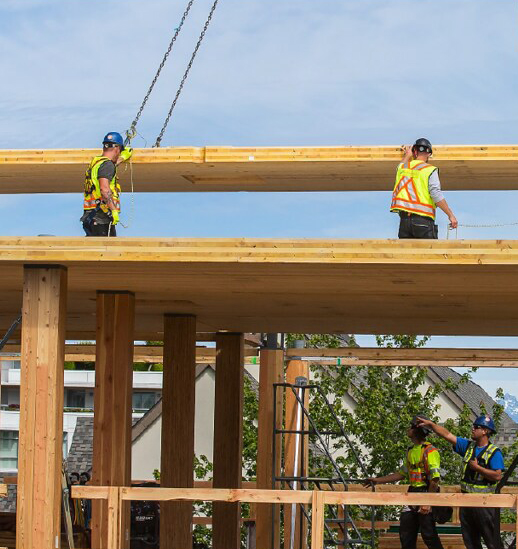
The British Columbia government announced that it will provide $4.2 million in funding to 12 mass timber demonstration and research projects and that it has established an advisory council to accelerate the adoption of mass timber building systems in the province. The demonstration projects include a diversity of building types and uses, including a fire station with strict post-disaster requirements, a health and culture center, and affordable housing. Meanwhile, the research projects focus on mass timber’s fire performance, cost-efficiency, and carbon benefits.
In announcing these investments, British Columbia Premier John Horgan stated, “Mass timber is good for forestry-dependent communities, workers, and the environment—because it adds value rather than just volume” and “growing the sector is key to building a strong and sustainable economic recovery that reaches everyone.”
Read more about these investments here.
Michigan State U. Hopes to Spur Regional Adoption of Mass Timber
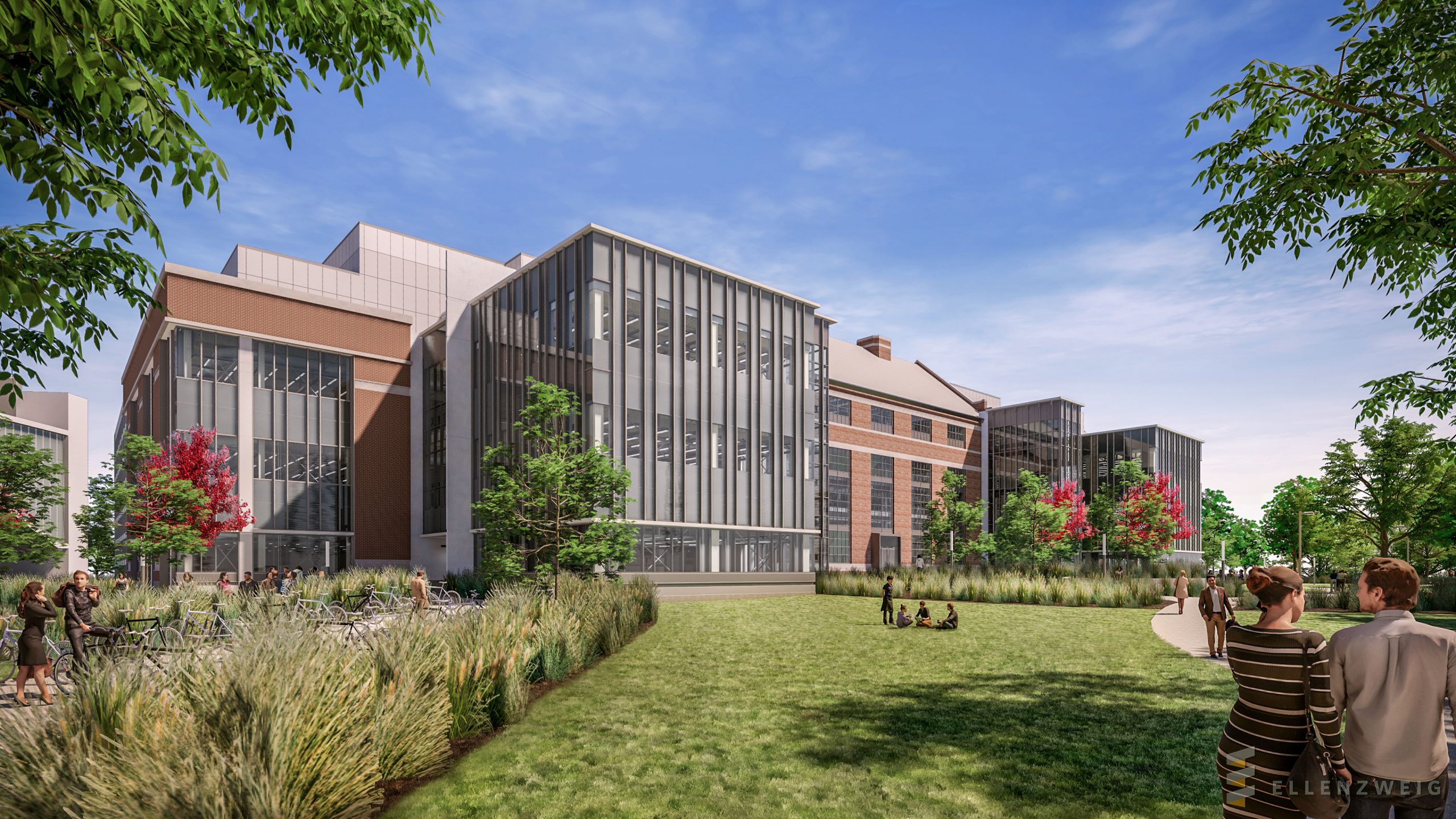
Michigan State University (MSU) recently completed its 157,000-square-foot STEM Teaching and Learning Facility in East Lansing. The building is the first of its kind in Michigan, having been constructed primarily from mass timber. The building is part of Michigan State’s growing commitment to leverage its rich history in forestry and become a modern-day leader in mass timber in the region.
According to George Berghorn, an assistant professor of construction management in the School of Planning, Design and Construction, “We were a little late to the game in the Midwest . . . MSU is really trying to establish the fact that we have a viable research and development program here on campus looking at the material and also looking at how it is used in design and construction. Hopes are that we will eventually be able to attract a mass timber manufacturer to the state.”
Adding to mass timber demand, the Michigan Department of Natural Resources is designing its own $5 million mass timber building on Michigan’s Upper Peninsula.
Read more about MSU’s uptake of mass timber here.
WoodWorks Expertise on Display in Bisnow Piece on Embodied Carbon
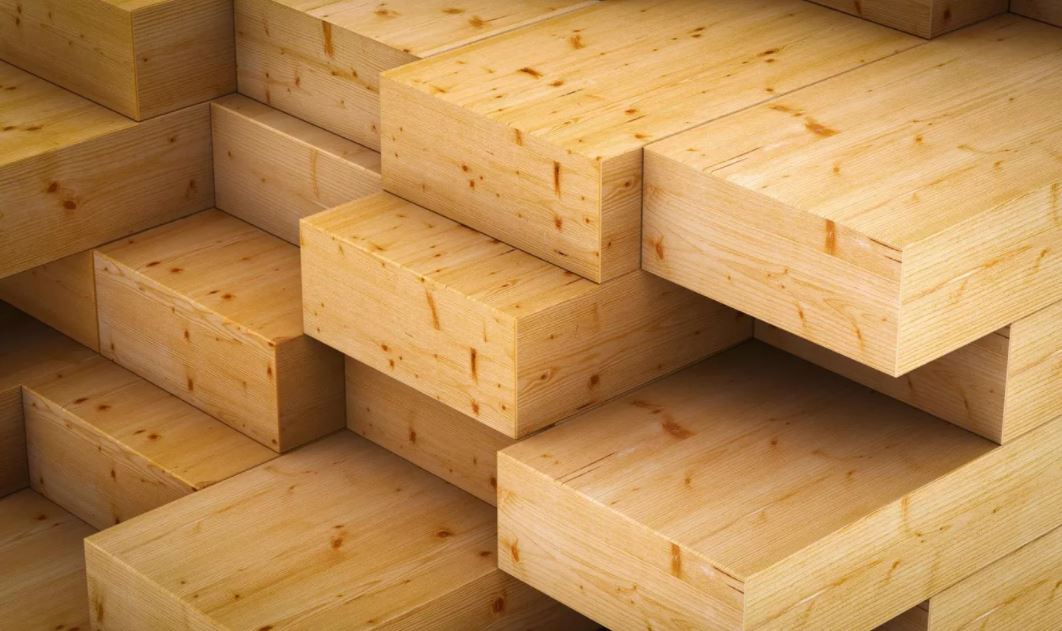
Bisnow recently ran a piece on the importance of reducing embodied carbon alongside operational carbon to drive down building emissions. The article cites WoodWorks’ Regional Director, Chelsea Drenick, who spoke on the topic at a Home and Environment webinar hosted by the Housing Action Coalition on Earth Day. Drenick noted that buildings generate almost 40% of the world’s annual greenhouse gas emissions.
According to Drenick, although operational carbon surpasses embodied over the lifetime of a building, it takes 17 years for operational carbon to surpass embodied carbon. This means that efforts to reduce embodied carbon can have a large and immediate impact in combating climate change.
The article notes that while new types of concrete are being developed with sustainability in mind and steel can claim credible sustainability benefits thanks to its high recyclability, wood remains the leading building material for reducing greenhouse gas emissions and is the only truly renewable building material.
Read more here.
Holes and Wood Combine to Offer New Noise-Reduction Innovation
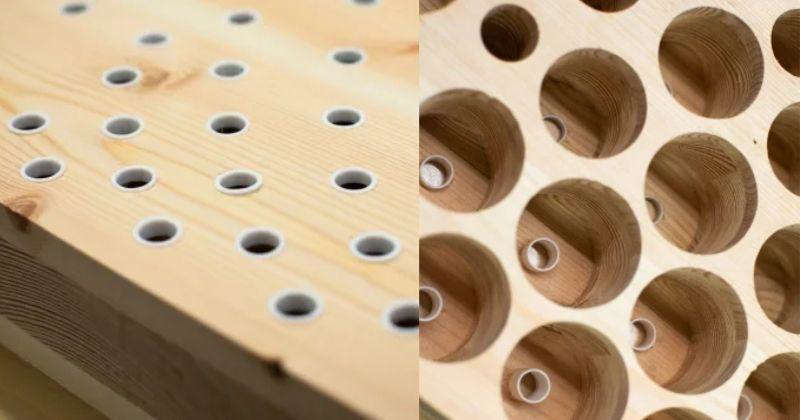
As first reported by FastCompany, a team of architects from NBBJ and researchers from the University of Washington have developed a prototype wood wall that reduces noise levels. The research team studded wooden walls with numerous small holes with bottle-shaped cavities and narrow necks that can trap sound. Through testing, the team determined an optimal array of holes, which they installed on a large CLT panel that can be used for a wall or ceiling. Initial testing of this installation reduced noise by 13 decibels, a 60% reduction.
Read more about this innovation here.
FPInnovations Stresses Tall Wood Buildings as Key to Achieving Canadian Climate Goals
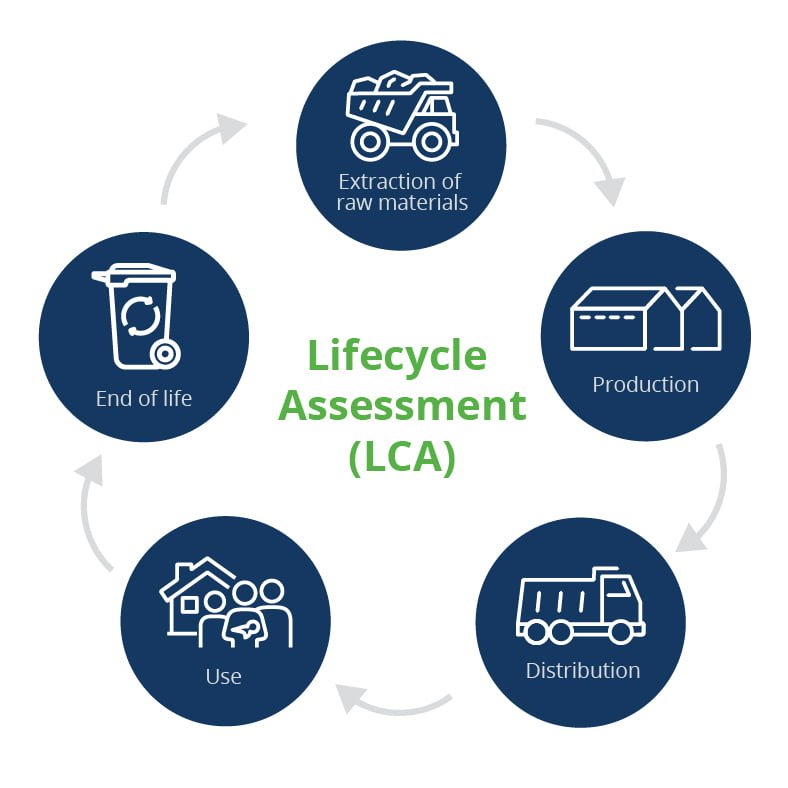
In contemplating how Canada can achieve the goals of its climate change plan, including net-zero emissions by 2050, FPInnovations highlighted the potential role of constructing multistory buildings with wood as a key intervention to reduce the building industry’s carbon footprint. According to Patrick Lavoie, a FPInnovations senior sustainability scientist, “Tall wood buildings can play a big role in helping lower Canada’s greenhouse gas emissions because they store carbon and sequester it for long periods of time, and because wood can replace more carbon-intensive materials.”
In the same piece, FPInnovations stressed the importance of using science-based LCAs to support climate-sensitive decision-making, identify opportunities to improve the environmental performance of supply and production chains, and avoid environmental burden shifting
Read more from FPInnovations here.
Insights on the Competition
AISC Promotes Steel’s Recyclability at Wood’s Expense
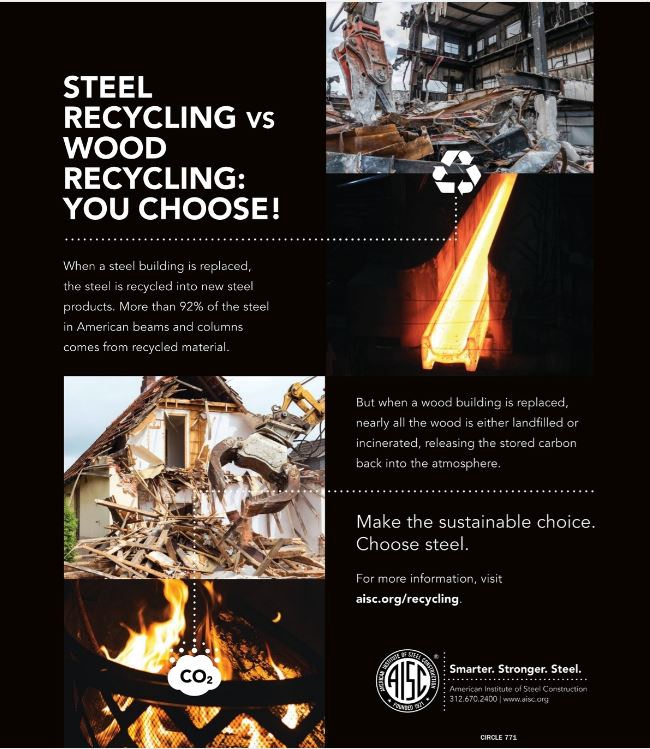
The American Institute of Steel Construction (AISC) recently published new marketing material to tout steel’s recyclability, stating that more than 92% of the steel found in American steel beams and columns is derived from recycled material. The piece goes on to contrast steel’s recyclability with wood’s, asserting that wood from old buildings is destined for landfills or incinerators, with the latter triggering the release of previously stored carbon.
See AISC’s piece here.
Industry Resources
FEA’s Housing Dashboard
This housing dashboard is provided compliments of Forest Economic Advisors (FEA):
View the April Dashboard
Virginia Tech's Monthly Housing Report
This monthly housing commentary report is a free service of Virginia Tech and is intended to help one gauge future business activity in the U.S. housing market.
March 2021 Reports (released in May 2021)
Part A: March Housing Commentary
Part B: March Economic Conditions


